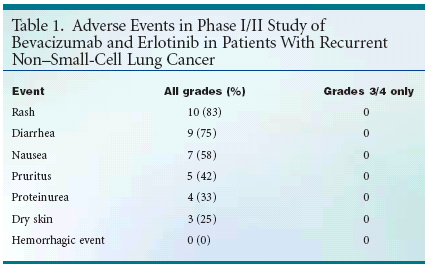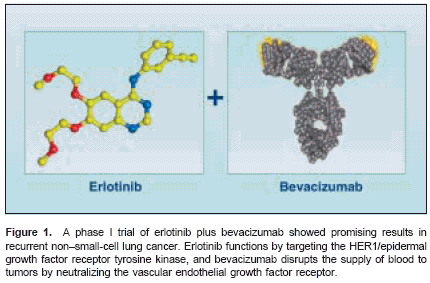Erlotinib Plus Bevacizumab Combination Safe and Promising Against NSCLC
This special “annual highlights” supplement to Oncology News International is acompilation of major advances in the management of lung cancer during 2003, asreported in ONI. Guest editor Dr. Roy Herbst comments on the reports includedherein and discusses advances in the clinical management of lung cancer, with afocus on developments in targeted therapy, new combinations, adjuvant therapy,induction therapy, and what to watch for in 2004.
CHICAGO-Encouragingearly results reported from a phaseI trial of bevacizumab (Avastin) pluserlotinib (OSI-774, Tarceva) in patientswith recurrent non-small-celllung cancer (NSCLC) have boostedinterest in testing combinations ofnovel agents, according to a reportpresented at the 39th Annual Meetingof the American Society of ClinicalOncology (ASCO) (ASCO abstract2521) (Figures 1 and 2).The combination not only showedantitumor activity, but also was welltolerated by the first 12 patients in thestudy. Three had a partial response(producing a response rate of 25%),and five had stable disease (a rate of42%). Although a majority of patientsexperienced rash, diarrhea, and/ornausea, no adverse events reachedgrades 3 or 4, and no bleeding wasrecorded (see Table 1)."We're very excited," senior investigatorRoy S. Herbst, MD, PhD, ofthe University of Texas M. D. AndersonCancer Center, Houston, toldONI. "Now we have 25 patients. Twentyhave been evaluated, and we stillhave a response rate of 25%. Evenmore importantly, the drugs are safe.You can give a full dose of Avastin, afull dose of Tarceva."Eric D. Mininberg, MD, a seniormedical oncology fellow at M. D.Anderson Cancer Center, reported thepreliminary results in a poster sessionand Dr. Herbst used them as the basisfor his presentation at a post-ASCO,industry-sponsored, satellite symposium,"Targeting Critical Pathways inOncology."


Synergism SoughtAn antiangiogenic agent, bevacizumabis a monoclonal antibody thatdisrupts the supply of blood to tumorsby neutralizing the vascular endothelialgrowth factor (VEGF) receptor.
Erlotinib is a small molecule that blocksa key signaling pathway in tumorgrowth by targeting the HER1/epidermalgrowth factor receptor (HER1/EGFR) tyrosine kinase (see Figure 1).The investigators hoped for a synergisticeffect between the two agents,according to Dr. Mininberg. "As weare learning more and more abouttargeted therapies, there's a lot ofcrosstalk between these two mechanismsand especially in lung cancer,we know there's overexpression ofEGFR as well as VEGF," he said.In a discussion of NSCLC results,Alex Adjei, MD, PhD, a medical oncologistat the Mayo Clinic in Rochester,Minnesota, singled out the approach inthe bevacizumab/erlotinib trial as themost promising. He called the combinationof novel targeted agents "an importantmove forward and probably theway we should be going."Emphasizing the complexity of cancercells, Dr. Adjei told ONI that blockingone pathway would probably havelimited effect because cancer can bypassthat pathway and find anotherway to activate downstream signalingmolecules such as ERK. "If you havethese agents that block different pathways,then you can block ways of thetumor escaping," he said, describingmultiple target inhibition as the key toimproving survival rates for patientswith lung cancer.New Approaches NeededDr. Adjei, Dr. Herbst, and Dr. Mininbergeach emphasized the need for anew approach in light of the low successrate and high toxicity of chemotherapyin lung cancer patients. "Wehave targeted therapies that we talkabout being less toxic and easier togive, so the first thing we do is combinethem with chemotherapy," Dr.Herbst said, calling for more studies ofnovel agents in combination with eachother."Combinations should have a rationale,"he added, cautioning that researchers should not "just start tomix and match indiscriminately."Conducted with investigators fromGenentech Inc. and Vanderbilt University,the ongoing bevacizumab/erlotinib study is expanding to 48 patientsfor phase II. Inclusion criteriainclude histologically proven stageIIIB, IV, or recurrent nonsquamouscell NSCLC, Karnofsky performancestatus of ≥ 70, and at least one priorchemotherapy regimen for recurrentor metastatic disease. Patients withprior therapy targeting EGFR or VEGFare excluded.Based on phase I, the investigatorsare examining a maximum tolerateddose of 150 mg per day of erlotinib and15 mg/kg of bevacizumab given intravenouslyevery 21 days. Dr. Mininbergsaid the researchers hope to doproteomic studies in phase II. Theprotocol includes baseline and followupbiopsies for measurement of bloodvessel counts, EGFR and VEGF expression,and other markers.